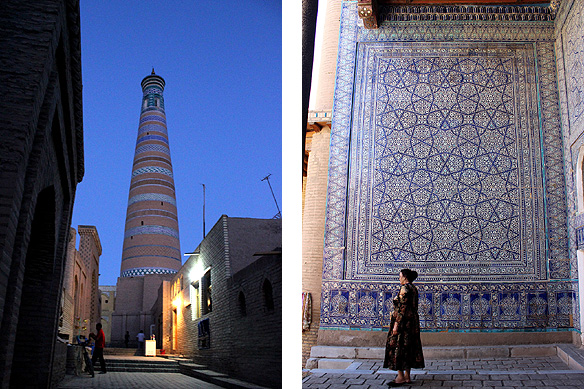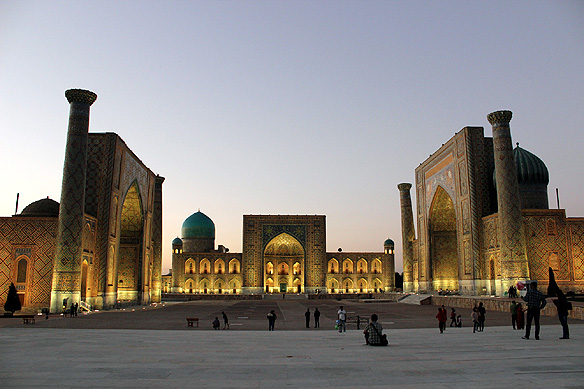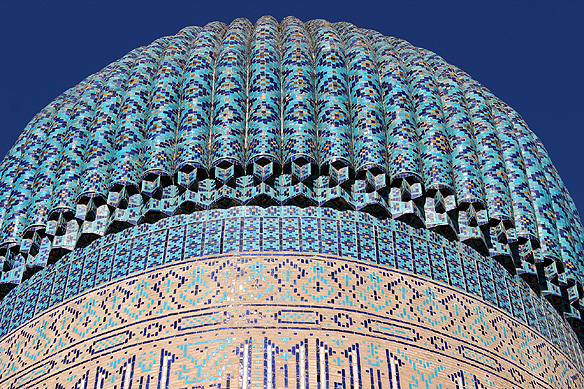[I traveled to Uzbekistan for 11 days in September 2015. My below post first appeared as a travelogue in Hindustan Times, one of the largest newspapers in India, in both its print and online editions. The online edition can be read here. The post remains a personal favourite, and I wanted to share it with you. 🙂 ]
– – –
‘Ishani!’ I can feel scores of eyes bore into me. There is the blatant stare, the questioning glance, the shy surreptitious gaze. They are all invariably accompanied with the word ‘Ishani’ whispered in hushed tones. The wide-cheek-boned faces soon, thereafter, break into warm welcoming grins and I hear the magical word again, ‘Ishani’. Aah, I get it. It’s a greeting! Ishani to you too, my dear.
I have just arrived in Nukus, a remote, Russian-ised town in north-west Uzbekistan where I am to start my 11-day journey across a country I have dreamt about, bucket listed and hankered to visit since I read the poem The Golden Journey to Samarkand by James Elroy Flecker:
“We are the Pilgrims, master: we shall go
Always a little further …
White on a throne or guarded in a cave
There lives a prophet who can understand
Why men are born.”
I am a pilgrim here too, looking for answers. Nukus is not part of the usual Uzbekistan travel itinerary. It lies snuggled on the country’s edge and is an eight-hour drive away from Khiva through the Qyzylqum desert. So why go to Nukus? If you are an art lover, Nukus houses the world’s second largest collection of Soviet avant-garde art at its Savitsky gallery. If you are passionate about the environment, the dying Aral Sea nearby is a reality check of how economics depletes our natural resources.
Uzbekistan broke away from the Soviet Union in 1991. In many respects, the country is still in transition. As it explores foreign ties, walled in by a predominantly Russian and Uzbek speaking populace, an Indian serial dubbed in the local language has woven its way into the lives of the people here. The lead character of this serial is Ishani. This insight is divulged in a tiny café in the local bazaar over a three-in-one cup of tea (translated to tea with milk and sugar). A mother-daughter pair at the adjoining table want to get pictures taken with me, their conversation interspersed with the expected ‘Ishani’.
Not able to handle my own imagination and its half-baked conclusions anymore, I ask, careful not to offend such overt affection, “who is she/it/that?” I am first met with sheer disbelief at my ignorance. This is followed with dramatic gestures on eternal love and a new word ‘Ranveer’.
Seeing my vacant expression, they zip out their phones, google and show me images of ‘Ishani’ captioned in Uzbek. Since I am not a TV enthusiast nor do I understand Russian or Uzbek, it all remains confusing. A serial called Ishani? Well for now this is to suffice for it is time for me to leave for Khiva.
[Note: Top image: The azure dome of Gur-Emir.]

The ‘Ishani’ effect at Mizdahkan necropolis, Nukus.

Ayaz Qala 2, 3rd Century Khorezm fort in the Qyzylqum desert.
Stopping en route to scramble over the walls of Chil’pyk, a Zoroastrian Tower of Silence and crumbling fortifications of a string of Khorezm forts dating back to the third century, I reach the 2,000-year-old town of Khiva at dusk. As I open my bedroom window to one of the most beautiful sights so far—the towering Islam Khodja Minaret—I muse if Ishani is incidental only to Nukus. Khiva assures me otherwise. Come evening, I see all the Uzbeks running home. “What happened?” “Ishani is going to start soon!” The town is at this point left to the tourists, who have to fend for themselves!
Khiva’s old town is steeped in legends and packed with over 50 monuments and 250 old houses inside its 17th Century walls. Within its carefully manicured folds, 1,000 years of time coexist in uncanny harmony, whether it is the columns of the Djuma mosque, college students in figure-hugging jeans coming in for a short prayer at one of the shrines or the madrassas converted to museums.

Left: View from a window, Islam Khodja minaret built in 1910; Right: Just another wall decorated with blue majolica tiles, 19th Century Tosh Hovli palace, Khiva.

Forest of over 200 ornate wooden columns at the Djuma mosque, Khiva.
Whilst Khiva is small and intimate, Bukhara is larger and more structured with distinct burial, administrative, religious and trading areas. Bukhara is also where, because of a populace better at English, I learn that Ishani is the lead character of Meri Aashiqui Tum Se Hi, a TV serial produced by Balaji Telefilms. It premiered on 24 June, 2014 on Colors TV in India, and has since been dubbed and is broadcast in Uzbekistan every day at 7 pm.
Wandering through Bukhara’s lanes I come across young women with bindis on their faces dressed in punjabi suits replete with dupattas. “My Muslim name is Sara. My Indian name is Sarita.” A peal of joyful blushing laughter follows this introduction.
One may well ask why a foreign nation is so enamoured by this tele-serial. I am told it is ‘Indian love’ epitomizing loyalty and familial love. Importantly, it is the only Indian serial broadcast in Uzbekistan.
As I explore Khiva and, then, Bukhara I meet countless people and have an equal number of pictures taken with them—all I can say is I must have graced many a facebook wall during my stay, all because in some remote way I epitomized Ishani.
Less touristy, merrier with Uzbeks dancing and singing in the central squares, Bukhara was once upon a time called the ‘Muslim Dome’ and has historically been an Islamic religious and learning centre. 140 turquoise tiled minarets, madrassas and mausoleums adorn it; Poi Kalyan Complex, Ulug Begh’s Madrasah and the to-date sacred site of 14th century Sufi saint Bakhouddin Nakshabandi are testimonies of its spiritual legacy.

Ancient Ark Fortress walls, Bukhara.

Left: 14th Century Sufi saint Bakhouddin Nakshabandi pilgrimage site, Bukhara; Right: Abdul Aziz Khan madrasah (1652), Bukhara.

Detail, 16th Century iwan of the Mir-i Arab madrasah, Bukhara.
Finally, like the travellers in medieval times who traversed the desert to reach the glory of Samarkand, I reach it too, via Shakhrisabz, Temur’s home town.
Samarkand is best described in just one word—Opulence. Christened Afrasiab, it was the ancient capital of Sogdiana and later became the capital of Temur and his empire. One glance at the Registan edged with its three magnificent madrassas, royal necropolis Shah-i-Zinda and Gur Emir, ‘grave of the ruler’ where Temur and his descendants are buried are enough to take one’s breath away.

The ‘Ishani’ effect at Registan, Samarkand.

The Registan edged with its three magnificent madrasahs, Samarkand.

Royal necropolis Shah-i-Zinda (11th-19th Century), Samarkand.
So did I find my answers in Samarkand, you may well ask me. Yes, I did. On a spiritual note, I learnt that for the pilgrim, it is all about the journey, and if it were not for Nukus, the Khorezm forts, Khiva, Bukhara, and Shakhrisabz there would be no Samarkand. The journey to Samarkand is the journey to the opulence within ourselves. On a more realistic note, all you need to connect disparate nations is a tele-serial.
Eleven days in a Central Asian country and everyone I met greeted me with love, respect and warmth. I was the only Indian woman traveller; in fact I did not come across a single other Indian. Yet, I was welcomed with open arms. What no foreign policy or trade relation between India and Uzbekistan could achieve, an Indian tele-serial has been able to do. It has brought India to the hearts, minds and homes of an entire nation. The gleam which Ishani triggers is unparalleled.
Thank you, Uzbekistan, and I guess it would be only fair to say, thank you, Ishani, for making my journey to Samarkand in every sense—a homecoming.


Wow this is much more than a post! It is a trip to Uzbekistan! Wonderful shots.
LikeLike
Thank you super much 🙂 Glad you liked it!
LikeLiked by 1 person
I always thought Indian tv serials were good for nothing. Really, Uzbekistan? 😮 😱
LikeLike
Yes, and that too a Balaji one replete with much drama. 🙂 The quirks of reality.
LikeLike
Absolutely stunning captures..
LikeLike
Thanks much Steps Together. It is very kind and encouraging of you to say so. Deeply appreciated. A beautiful country makes for beautiful pictures. 🙂
LikeLike
Amazing places and fab photos. Now I dream of a journey to Uzbekistan!
LikeLike
And dreams are meant to be made true 🙂
LikeLiked by 1 person
Amazing captures and beautiful portraits! We were virtually transferred to Samarkand while reading this post, absolutely loved it!
LikeLike
Thank you for stopping by and commenting. Your compliments have made my day! 🙂 Am so glad intrepid travellers like yourselves are enjoying the post.
LikeLike
Beautiful photos Rama, and they remind me a lot of my trip to Iran, very similar. I remember watching Shah Rukh Khan on the telly in Iran, his lines dubbed in Arabic and sub-titles were in Farsi – true, sometimes a mundane thing like a tele-serial can bring nations together 🙂 I enjoyed reading your post, congrats on its feature in Hindustan Times, thanks for sharing…
LikeLike
Thank you Kat! As always you are so very supportive and kind in your words. Means a lot. 🙂
LikeLiked by 1 person
Beautiful… everything about it, may i have the URL to your HT feature
LikeLike
Hey, thanks so much Bagchi! Super appreciated. 🙂 The HT feature link is in the last line of the post: ‘The online edition can be read here’. The URL for the link is http://www.hindustantimes.com/travel/samarkand-diaries-love-for-tv-soaps-added-to-native-hospitality/story-jwJegA6aYQL587P21AIA3K.html
LikeLike
Oh this is unexpected! The last time someone told me about travel in Uzbekistan, it was about sex tourism and how it’s ruined for Indians.
This goes back up on my list now!
LikeLike
Haha. Glad to break misconceptions and share fresh perspectives through my blog posts 😀
LikeLiked by 1 person
What a brilliant write up. And Samarkand has such stunning landscape and architecture. So very well maintained. And to see that people there love indian serials the same area from where Temur had come….world has come quite far and is a much better place now indeed. 🙂 Had read all your Uzbekistan posts last week but got a chance to comment on them today.
Lovely blog 🙂
LikeLike
Thank you Vishvarsha for stopping by and your lovely kind comment! Much appreciated. Yes, much of life is about going full circle and it is all the more obvious in retrospect. Am glad you enjoyed the Uzbekistan series. Trust you enjoy the rest of the blog too. 🙂
LikeLike
Lovely!
Indians movies had always been popular in that part of the world and I knew that but the serials too!
Cheers,
Rajiv
LikeLike
I know! I was equally taken by surprise. 🙂
LikeLiked by 1 person
That’s one of the best things about traveling to lesser known places. Surprises.
Cheers,
Rajiv
LikeLike
You were lucky that Ishani is the protagonist. Otherwise, your journey would be very unpleasant, with a lot of stare and glare 😛 Indian serials are quite popular in Vietnam as well. And it’s kind of amusing to hear discussions about them.
LikeLiked by 1 person
Haha. But one thing I am sure of: if there was no Ishani, there would have been no stares. None at all. Uzbekistan is super safe, and its people one of the kindest to travellers. Maybe because historically they are used to having travellers, from way back during the days of the Silk Road. 🙂
LikeLiked by 1 person
nice place and very thankful
LikeLiked by 1 person
Hello Anikasandeep, welcome to my blog. 🙂 Glad you enjoyed the post!
LikeLike
Welcome
LikeLike
Spellbinding is all I can say. Incidentally, India and Indians enjoy great respect across west Asia starting from Iran to Russia. Is it our culture? warmth? diplomacy? I suppose there are many elements at play here!
LikeLiked by 1 person
Indeed. I have only been welcomed with warmth in these regions. The connect is not recent. It goes back many years, at times centuries, and has been built on by the ever-effervescent Bollywood, and in the case of Uzbekistan a telly soapie. 🙂
LikeLike
oh my god !!!! this is so beautiful and especially blue majolica tiles decorated pillar.
LikeLiked by 1 person
Uzbekistan’s monuments are an absolute delight! And yes, their tile-work is pure gorgeousness. 🙂
LikeLiked by 1 person
They are really beautiful 😍😍😍
LikeLiked by 1 person
Again it’s something new to the store of my knowladge..uzebeks r indeed Great! Yes ishani has created a great impact on the people of Uzbekistan. Great work. Keep rocking🤗👍
LikeLiked by 1 person
Glad you enjoyed the post, Tanya. Uzbekistan stands apart from other middle eastern countries with its Russian, Sufi, Zoroastrian, Bukhara Jews, and Temur connects. The end result is an eclectic and fascinating combination which our very own Ishani has been able to appeal to, across the board! 🙂
LikeLiked by 1 person
Yes I did enjoyed a lottt.. Keep rocking✌😊
LikeLiked by 1 person
Wao ❤️
LikeLiked by 1 person
Welcome to my blog, Astiv218. 🙂 Am happy you enjoyed the post.
LikeLiked by 1 person
Pingback: why tashkent needs to be in your travel bucket list | rama arya's blog